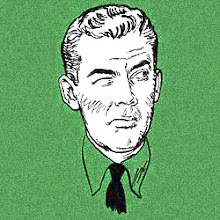 Liz Taylor is Gloria Wandrous, the stylish call girl yearning to go straight. Somehow she thinks Weston Liggett (Laurence Harvey) is her Real Guy, but this is surely hard for anyone seeing the film, then or now, to believe, since Liggett hates himself so much, seethes with anger, has become an alcoholic, and could snap at any moment. Gloria hates herself too. She misses her dead father, and her mother's then-new husband raped her when she was 13, a story she tells her lifelong best friend, played by Eddie Fisher (then married to Taylor).
Liz Taylor is Gloria Wandrous, the stylish call girl yearning to go straight. Somehow she thinks Weston Liggett (Laurence Harvey) is her Real Guy, but this is surely hard for anyone seeing the film, then or now, to believe, since Liggett hates himself so much, seethes with anger, has become an alcoholic, and could snap at any moment. Gloria hates herself too. She misses her dead father, and her mother's then-new husband raped her when she was 13, a story she tells her lifelong best friend, played by Eddie Fisher (then married to Taylor).It's BUtterfield 8, based on the 1935 novel by John O'Hara. I haven't read the novel (but will): I hear that in the novel Gloria is an out-and-out escort. In the 1960 film about half the time you know a stylish prostitute is what you get when you dial the famous number. The other half the time it seems that she's a clothing model, somewhat on the up and up. There's denial all around: Liggett's wife tries not to react to her husband's sprees of infidelity; Gloria's mother can't see that her daughter is a tramp, for perhaps it would be a key to the fraught scene of the girl's weeklong deflowering at the hands of the mom's husband; the Eddie Fisher best friend can't seem to sort out his feelings for Gloria, although in the end gets it right (decides to marry his straight-good girlfriend while continuing to be decently helpful to Gloria).
 In the end, after an almost utterly expected car crash, we have to hear Liggett, of all people, say how good a heart Gloria had inside, in spite of it all - a contender for the most unconvincing speech in any film I've seen. (Not because we have no sympathy for Gloria, but because the film chooses Liggett to express it. Where did that come from?)
In the end, after an almost utterly expected car crash, we have to hear Liggett, of all people, say how good a heart Gloria had inside, in spite of it all - a contender for the most unconvincing speech in any film I've seen. (Not because we have no sympathy for Gloria, but because the film chooses Liggett to express it. Where did that come from?)Freudian possibilities are dragged across the plot, and these are wandrous too. Therapy gets a satiric knock, which hints at the film's use of the sexualized parental relationship as a creaky stage prop and little more. In a truly comic scene, Gloria goes to her shrink, played by George Voskovic (he was the Swiss watchmaker juror in Twelve Angry Men), and announces that she no longer needs therapy, since she has finally found the man who will send her straight. She marches happily out of the doc's office and we get to see his startled facial response as that quick scene ends.
 Gloria and Liggett have huge psychological problems, perfectly matched. He wants someone to abuse him. She wants to give some abuse as a way of keeping herself from obtaining yet another sex partner. At one point, when she wants some distance from him (although she's already fallen in love with him), she digs her sharp stiletto heel into his shoe - for a long time. The camera lingers on the heel stuck into the leather for so long, and on his impervious face (feeling pain but not showing it, wanting to be different from the other guys who wince at this old trick of hers), that one wonders where the Catholic League of Decency was when this film came out. I nearly called them myself when watching this film the other night. Yet the only number in my head was the oft-repeated "BUtterfield 8." Well, some wise guy putting clips up on YouTube has reproduced this scene and dubbed it "The Heel Trick." Have a look if you dare.
Gloria and Liggett have huge psychological problems, perfectly matched. He wants someone to abuse him. She wants to give some abuse as a way of keeping herself from obtaining yet another sex partner. At one point, when she wants some distance from him (although she's already fallen in love with him), she digs her sharp stiletto heel into his shoe - for a long time. The camera lingers on the heel stuck into the leather for so long, and on his impervious face (feeling pain but not showing it, wanting to be different from the other guys who wince at this old trick of hers), that one wonders where the Catholic League of Decency was when this film came out. I nearly called them myself when watching this film the other night. Yet the only number in my head was the oft-repeated "BUtterfield 8." Well, some wise guy putting clips up on YouTube has reproduced this scene and dubbed it "The Heel Trick." Have a look if you dare.Reportedly, Taylor and Fisher hated this film and referred to it as "Butterball 4." A turkey? Well, maybe, but are movies we call turkeys typically as complicated as this?
This film was one of the 30 most popular movies of 1960.

 Is '60 the moment when the end of the end of the Old Left had been reached and the New Left began to emerge? Is it the final ascendancy, in certain scenes at least, of poetic postmodernity? Surely the publication of Donald Allen's The New American Poetry that year suggests this, but then again--once again--we look back on "New" here and see continuity. The rhetoric of the Kennedy-Nixon contest made much less of a dent than everyone (at the time as well as since) claimed, so one wonders why were such great claims made?
Is '60 the moment when the end of the end of the Old Left had been reached and the New Left began to emerge? Is it the final ascendancy, in certain scenes at least, of poetic postmodernity? Surely the publication of Donald Allen's The New American Poetry that year suggests this, but then again--once again--we look back on "New" here and see continuity. The rhetoric of the Kennedy-Nixon contest made much less of a dent than everyone (at the time as well as since) claimed, so one wonders why were such great claims made?  Had we come to expect "1960" to be truly ubiquitously modern in a way that the 1950s really were not--not quite? And what specifically does "modern" mean in the Kennedyesque talk then and now about the torch being passed to a new generation, etc.? The First Lady really meant "modernist" when Camelotians said "modern." What about the others across the new young cultural leadership? I've been surprised by how frequently the
Had we come to expect "1960" to be truly ubiquitously modern in a way that the 1950s really were not--not quite? And what specifically does "modern" mean in the Kennedyesque talk then and now about the torch being passed to a new generation, etc.? The First Lady really meant "modernist" when Camelotians said "modern." What about the others across the new young cultural leadership? I've been surprised by how frequently the  "Beat movement" was covered in 1960 in the mainstream press. I was expecting a fair measure but I've found tonnage. 1960 was the year when the figure of the beat was beginning to find acceptance, although still 80% of these stories are mocking, rebels-without-cause condescension. For anyone whose analysis made an impact nationally, do these antipolitical adolescents count as part of the "new young cultural leadership"? No, but rather than the two being opposites, they fall along a Continuum of the New American. Now that's a change for '60.
"Beat movement" was covered in 1960 in the mainstream press. I was expecting a fair measure but I've found tonnage. 1960 was the year when the figure of the beat was beginning to find acceptance, although still 80% of these stories are mocking, rebels-without-cause condescension. For anyone whose analysis made an impact nationally, do these antipolitical adolescents count as part of the "new young cultural leadership"? No, but rather than the two being opposites, they fall along a Continuum of the New American. Now that's a change for '60.







